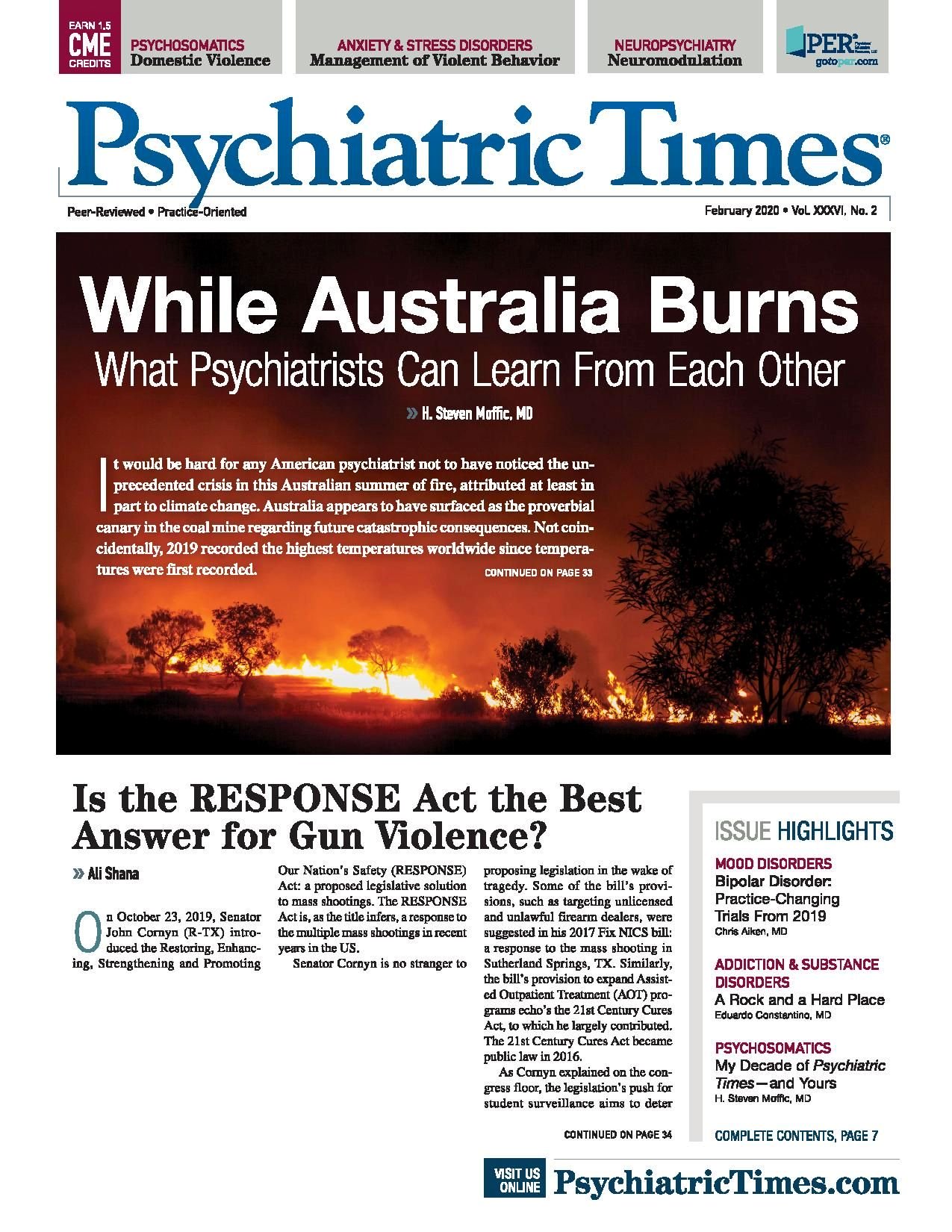Publication
Article
Psychiatric Times
Recognizing and Addressing Domestic Violence: Issues for Psychiatrists
Author(s):
A cultural shift has occurred and intimate partner violence (IPV) is no longer defined as a family affair, but one that has lasting effects on the individual, the family, and the community.
Table 1. Physical and behavioral outcomes of IPV
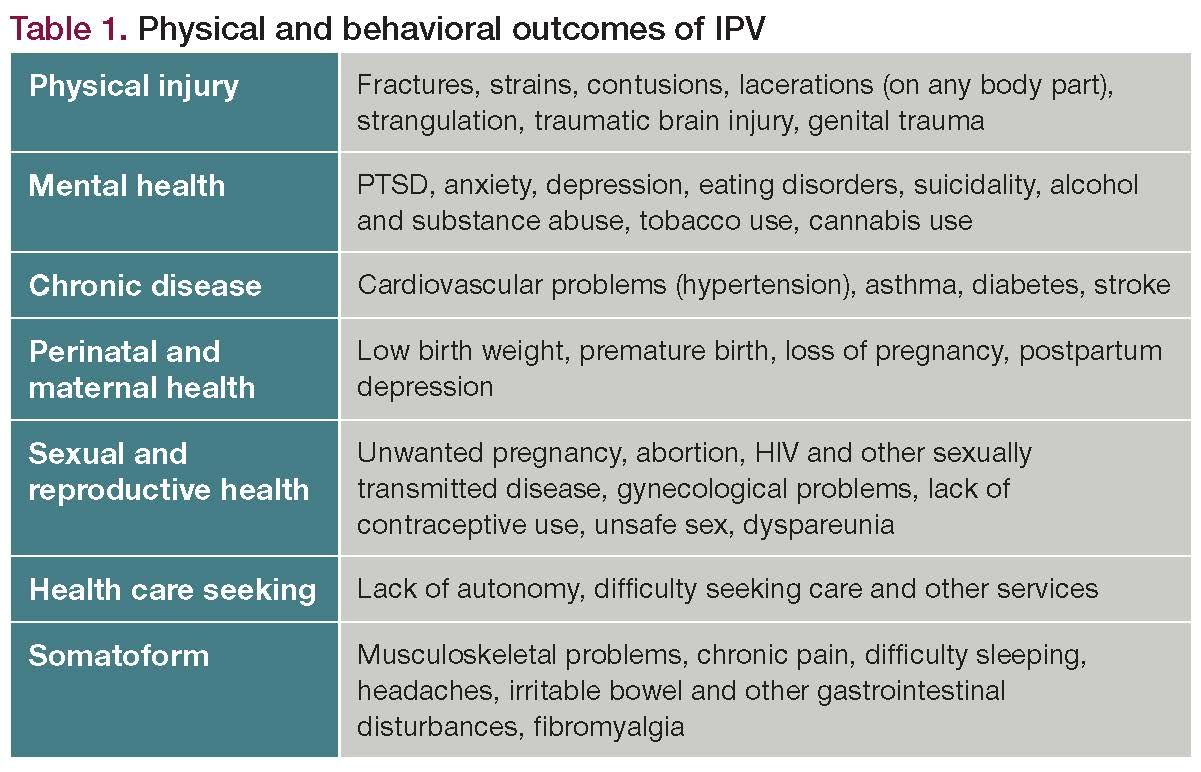
Figure 1. Data from the National Violence Against Women Survey [19]
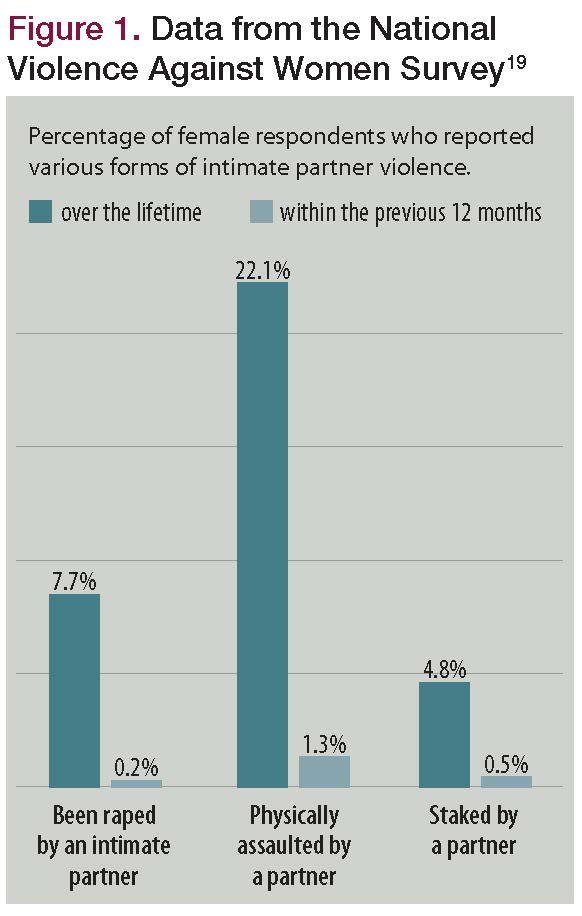
Figure 2. Risk factors of IPV
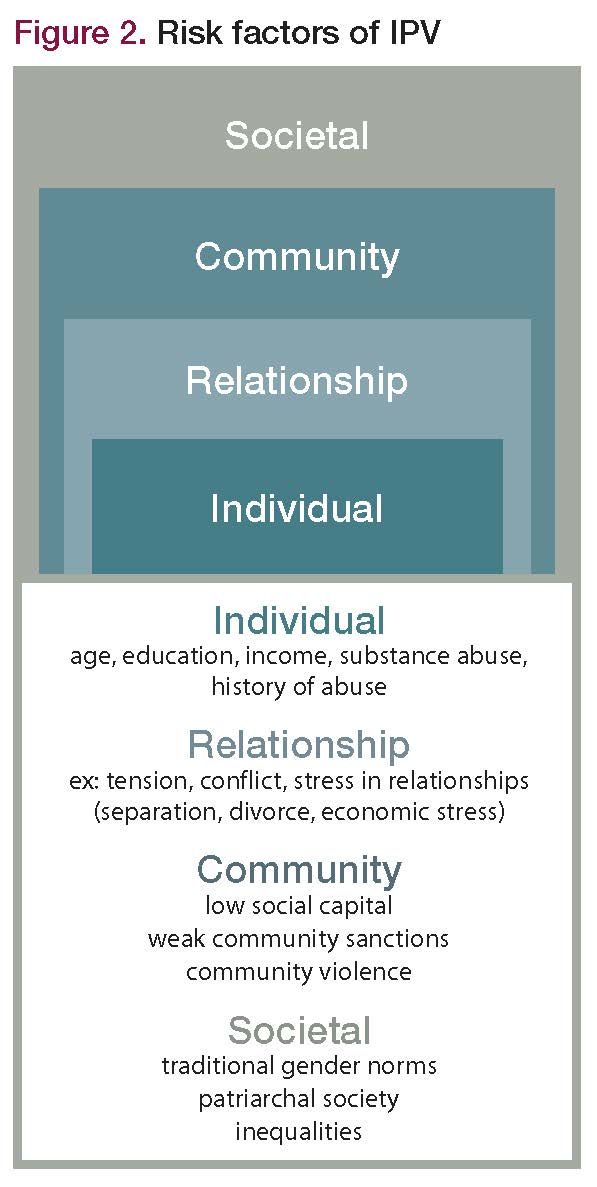
Table 2. Core principles of trauma informed care
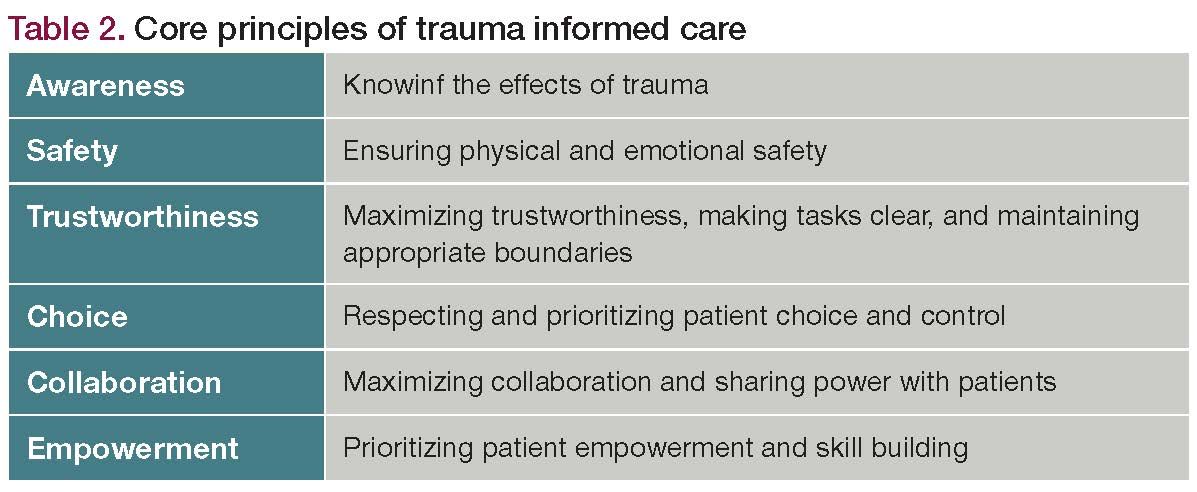
Table 3. Specific treatments
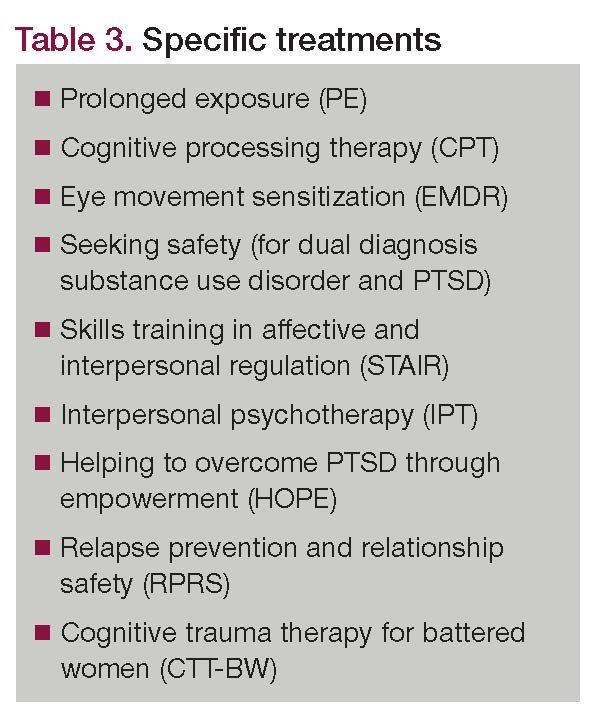
Premiere Date: February 20, 2020
Expiration Date: August 20, 2021
This activity offers CE credits for:
1. Physicians (CME)
2. Other
All other clinicians either will receive a CME Attendance Certificate or may choose any of the types of CE credit being offered.
ACTIVITY GOAL
The goal of this activity is to provide an understanding of intimate partner violence (IPV), ie, those most likely to be victims of IPV, those most likely to commit IPV, sequelae of IPV.
LEARNING OBJECTIVES
After engaging with the content of this CME activity, you should be better prepared to:
• Understand prevalence of intimate partner violence (IPV);
• Identify who is most likely to commit/be a victim of IPV;
• Define the Centers for Disease Control and Prevention criteria for IPV;
• Describe the sequelae of IPV and its impact on victims and perpetrators.
TARGET AUDIENCE
This continuing medical education (CME) activity is intended for psychiatrists, psychologists, primary care physicians, physician assistants, nurse practitioners, and other health care professionals who seek to improve their care for patients with mental health disorders.
ACCREDITATION/CREDIT DESIGNATION/FINANCIAL SUPPORT
This activity has been planned and implemented in accordance with the accreditation requirements and policies of the Accreditation Council for Continuing Medical Education (ACCME) through the joint providership Physicians’ Education Resource®, LLC and Psychiatric Times. Physicians’ Education Resource®, LLC is accredited by the ACCME to provide continuing medical education for physicians
Physicians’ Education Resource®, LLC designates this enduring material for a maximum of 1.5 AMA PRA Category 1 Credits™. Physicians should claim only the credit commensurate with the extent of their participation in the activity.
This activity is funded entirely by Physicians’ Education Resource®, LLC. No commercial support was received.
OFF-LABEL DISCLOSURE/DISCLAIMER
This CME activity may or may not discuss investigational, unapproved, or off-label use of drugs. Participants are advised to consult prescribing information for any products discussed. The information provided in this CME activity is for continuing medical education purposes only and is not meant to substitute for the independent clinical judgment of a physician relative to diagnostic or treatment options for a specific patient’s medical condition.
The opinions expressed in the content are solely those of the individual faculty members and do not reflect those of Physicians’ Education Resource®, LLC.
Recognizing and Addressing Domestic Violence: Issues for Psychiatrists
The authors, external peer reviewer, and the staff members of Physicians’ Education Resource®, LLC and Psychiatric Times have no relevant financial relationships with commercial interests.
For content-related questions, questions concerning the accreditation of this CME activity or how to claim credit, please contact PTEditor@mmhgroup.com and include Recognizing and Addressing Domestic Violence: Issues for Psychiatrists in the subject line.
HOW TO CLAIM CREDIT
Once you’ve read the article, please use the following URL to evaluate and request credit: https://education.gotoper.com/activity/ptcme20feb.
If you do not already have an account with PER® you will be prompted to create one. You must have an account to evaluate and request credit for this activity.
Intimate partner violence (IPV), is described as abuse occurring within the context of an intimate relationship, including physical, sexual, and psychological harm as well as economic, legal, or other forms of coercion. While the term domestic violence (DV) is often colloquially used interchangeably with IPV, DV can encompass a larger scope of family violence, including child abuse. The Centers for Disease Control and Prevention (CDC) defines IPV as: “physical violence, sexual violence, stalking, and psychological aggression (including coercive tactics) by a current or former intimate partner (eg, spouse, boyfriend/girlfriend, dating partner, ongoing sexual partner).”
While legal definitions vary by country, IPV is highly prevalent worldwide. The World Health Organization has called IPV a global public health problem of epidemic proportions that affects millions of individuals and families worldwide. Within the US, the CDC reports that one in three women and one in four men will experience physical and/or sexual violence by a partner or sexual violence by a non-partner.1 However, these reports are likely to be underestimated, because non-physical abuse (ie, psychological aggression: name calling, insulting or humiliating tactics, and behaviors intended to monitor, control, or threaten a partner) is often more difficult to capture in large cross-sectional studies. Strangulation, a common but unrecognized form of physical abuse, is less likely to be reported, despite its high morbidity and correlation with homicide.
With the advent of technology, newer forms of surveillance and control are available including tracking locations, phone usage, and monetary spending. These forms of harassment are not often captured in wide epidemiological studies.
IPV is often referred to as a form of gender-based violence, and the most common portrayal is one of a male perpetrator and female victim in a heterosexual couple. However, epidemiologic studies and surveys suggest a more complex relationship between gender and relationship violence. For example, in a large telephone-based survey, men and women reported roughly the same 12-month prevalence of IPV (5.8% and 5.6%, respectively).3 Nevertheless, there are significant differences by gender in the severity, frequency, type, and lifetime impact of IPV. Women are twice as likely to experience severe physical violence and are three times as likely to be injured due to rape, physical violence. or stalking (Figure 1). Moreover, they are more likely to die by homicide by a current or former intimate partner.4 Despite these differences, it is important to remember that men are also significantly affected by IPV and may not self-identify or present for services because of cultural and gender roles.
One theory for the discrepancy between the essentially equal rates of reported physical violence by gender in survey studies and the higher burden of severity and impact on women is to see IPV through the lens of power and control. Unlike mutual violence in high conflict relationships, “intimate partner terrorism” involves the use of multiple tactics-of which physical violence may be just one-to achieve an imbalance of power between the partners and to maintain the need for dominance.5,6
Nevertheless, the situational concerns of IPV can apply to both the victim and the partner doing harm; and often a person can be both the victim and the abuser, regardless of gender. The WHO advocates an ecological framework that views IPV as the interaction among many factors-individual, relationship, community, and societal (Figure 2). All these factors should be considered in discussing, preventing, and treating IPV for both the victim and the abuser.
Physical and behavioral outcomes of IPV
The health effects from IPV include physical injury as well as chronic conditions such as mental health disorders, urological and gynecological problems, sexual and reproductive health issues, sexually transmitted diseases, with consequent increases in morbidity and mortality (Table 1). Furthermore, IPV is associated with risky health behaviors such as unsafe sex, poor nutrition, cigarette use, and alcohol and drug use as well as limited health care seeking behavior, which also applies to the abusers.7,8
The likely causal pathways between exposure to violence and health outcomes are starting to be explored and better understood. These pathways are often complex, with environmental, physiological, behavioral and other factors influencing the likelihood of disease through poor coping behaviors (eating, substance dependence), immune and neuroendocrine dysregulation, neural pruning, alterations in brain connectivity, telomere shortening, and epigenetic modification of gene expression.
Mental health symptoms of IPV
In addition to the physical sequalae of IPV, the mental health effects also place a considerable health care burden on the survivors. As mental health professionals, psychiatrists may see a heterogenous range of psychological adverse sequelae. Several studies have extensively demonstrated an association between IPV and psychiatric disorders such as major depression, generalized anxiety disorder, posttraumatic stress disorder, eating disorder, panic disorder, substance use disorder, bipolar disorder, and psychosis.9 Within the outpatient and inpatient psychiatric population, the prevalence of prior and present IPV is more than 30%.10 Even those exposed to IPV without a diagnosed disorder commonly report insomnia, fatigue, irritability, forgetfulness, difficulty concentrating, and somatic complaints.
Furthermore, high rates of suicidal ideation and suicide attempts have been documented. In a recently published chart review of 106 patients with history of IPV who had access to mental health clinicians within the community, 40% reported prior suicide attempts and of those, 36% never received mental health care.11 These findings indicate both the severity of illness within this population and the limited access to mental health services.
Factors that increase the risk for the development of mental health sequalae of trauma include biological predisposition to mental illness, prior history of psychosocial adversity, intensity and chronicity of trauma, post-trauma adversities that in cases of IPV include life stress (eg, financial problems, housing access, loss of social support systems), which can be exacerbated when the survivor leaves the abusive relationship. However, it remains unknown how these factors can predict onset or severity of mental health symptoms.
Social support has been identified as a key protective factor against the development of mental health sequelae.12 Therefore, clinicians should engage in efforts to mobilize social supports and facilitate referrals to legal, medical, and psychosocial services as appropriate. These involve not only obtaining appropriate referrals but also educating survivors about the mental health symptoms that may emerge with trauma and that it is normal to need support.
More research is revealing the harm to children who witness IPV, including the effects from the experience of witnessing abuse as well as effects from parenting that is compromised. Witnessing such violence can contribute to psychological distress, behavior disorders, disturbances in self-regulation, difficulties in social interaction, and disorganized attachment as well as the eventual possibility of ongoing transgenerational transmission of violence. Research suggests that witnessing abuse carries the same risk of harm to children’s mental health and learning as direct abuse.13 Additionally, IPV alters caregiving parenting styles and adversely affects the mental health of the caregiver. Caregivers with adverse mental health outcomes from IPV are even more at risk for poor parenting skills.
Access to care
Given the extent of the seriousness of the mental health symptoms, the seriousness of the crime, and the difficulties of navigating the criminal justice system and the mental health system, survivors of IPV may require a range of sustained resources. These include but are not limited to access to emergency shelter, housing assistance, legal assistance, protection orders, safety planning, support groups, financial assistance, available childcare, and mental, medical, and oral health care. However, sometimes the mental health symptoms of a survivor may impede their ability to obtain adequate help.
There are significant structural and systemic barriers that prevent survivors from accessing mental health care. Some common barriers include perceived stigma associated with accessing services, financial barriers, decreased numbers of mental health clinicians that leads to long waiting lists, lack of services within a geographic area, language limitations, poor quality of treatment, and feelings of being re-traumatized by the medical system. Moreover, as part of coercive tactics in IPV, the abuser may limit the victim’s access to care and/or allege that the victim is a perpetrator of child abuse and neglect.
These obstacles are especially pronounced for minority women. Compared with white women in the US, minority women are less likely to seek help from various formal and informal sources.14,15 The health care system is currently insufficiently equipped to deal with both the mental health concerns and the advocacy concerns of IPV. Yet, there are few models of psychiatric service provisions aimed at treating survivors who require knowledge of both systems. Nevertheless, because of the high prevalence of mental health sequalae associated with IPV, the Substance Abuse and Mental Health Services Administration (SAMHSA) recommends that mental health professionals practice a trauma-informed model of care for all patients (Table 2). Not only does trauma-informed care apply to individual interactions, it also applies to the clinical environment, space, and all interactions including front staff who greet patients.
Confidentiality and documentation
A major barrier for survivors to report IPV is the concern of adding systematic monitoring to their lives. As mandated reporters, physicians have a duty to report harm to children. The same does not apply to the adult IPV survivor, which is dependent on state requirements that are often soft and not well defined. For example, in New York state, all potentially life-threatening IPV injuries that result from use of a firearm, a knife, or sharp object must be reported to the local police. California, however, has a more liberal stance. Physicians have a duty to report if they suspect the patient is suffering from a wound or physical injury because of abuse. A serious concern is that the reporting of IPV in the home may result in the removal of children from the home; this disproportionally affects minority communities.
Confidentiality and mandated reporting responsibilities should be addressed with patients who are seeking care, especially when assessing for IPV or sexual violence. Clinicians should familiarize themselves with their state law and reporting requirements. Not disclosing can disrupt the relationship with the patient and may put the patient at risk. Additionally, because a medical record may be used in subsequent legal proceedings, it is vital that the record is accurate and complete. It is useful to use a patient’s own words in quotation marks whether the patient is a victim or the person doing harm.
Treatment for survivors
In terms of treatment for IPV, there are various psychotherapy and psychopharmacological approaches. Because IPV is not a diagnosis but rather a phenomenon consisting of disorders from internalizing to externalizing, it is very difficult to study because, by definition, a randomized-controlled-trial must have a well-defined population. Nevertheless, because of the heterogenicity of mental health disorders stemming from IPV, psychopharmacology should target specific symptoms. Treatment of sleep disorders is frequently requested by those with IPV history and adequate treatment can garner increased rapport.
Psychotherapies may be used to address the multiple stressors of IPV survivors, including the immediate need for safety and resources, loss of an intimate relationship, social isolation, and issues regarding parenting issues. The common scenario for treatment for survivors of IPV may include three phases: safety and stabilization, processing traumatic material, reconnection and reintegration. Evidence-based treatments for IPV are listed in Table 3.
Perpetrators: background and treatment
Although controversial, there is increasing awareness that a serious public health approach to the problem of IPV must include treatment of perpetrators as wells as victims.16 A wide range of mental health disorders is attributed to perpetration: PTSD, anger, anxiety, depression, suicidal behavior, personality disorders, alcoholism or problem gambling as well as high incidences of comorbidity. Furthermore, perpetrators have a high likelihood of having been exposed to violence in their childhood, which has led to adverse mental health outcomes.
Treatment for those who do harm is more limited than for victims. Overall, group treatments for IPV batterers have meagre effects on the cycle of violence. Most studies, regardless of intervention strategies, report that approximately one in three cases will have a new episode of IPV within 6 months.17
Batterer intervention treatment programs (BIPs) serve as one of the primary societal responses to IPV, employing three primary modalities: psychoeducation (changing learned behavior), Duluth model (patriarchy and need for power and control as the root cause for violence), and ognitive behavioral therapy (deconstructing “dysfunctional” thinking). It is estimated that in the US at least half a million men enroll in approximately 2500 BIPs every year.18 However, BIPs in general have very high rates of participant attrition and poor results in preventing future violence. Few data exist concerning the mediators of BIP effects on IPV recidivism, and a variety of factors threaten to impede future design advancements, including turf battles regarding the causes of IPV and limited funding outlets.
Conclusion
A cultural shift has occurred and IPV is no longer defined as a family affair, but one that has lasting effects on the individual, the family, and the community. The mental health effects of IPV are paramount and require skilled clinicians to work alongside advocacy groups in providing much needed services. There is more work to be done, including understanding effective treatment for perpetrators within the context of family systems and becoming better attuned to crisis management especially when IPV is ongoing.
Given the prevalence of IPV within mental health settings, it is imperative for clinicians to be aware of risk factors, routine assessments, and effective interventions involved for both survivors and perpetrators.
CME POST-TEST
Posttest, credit request forms, and activity evaluations must be completed online at https://education.gotoper.com/activity/ptcme20feb (requires free account activation), and participants can print their certificate or statement of credit immediately (80% pass rate required). This website supports all browsers. For PER’s privacy policy, please visit https://www.gotoper.com/privacy.
PLEASE NOTE THAT THE POSTTEST IS AVAILABLE ONLINE ONLY ON THE 20TH OF THE MONTH OF ACTIVITY ISSUE AND FOR 18 MONTHS AFTER.
National Resources for Professionals and Patients
- National Domestic Violence Hotline 1-800-799-SAFE (7233); www.thehotline.org
- Family Justice Center Alliance (https://www.familyjusticecenter.org/) One Family Justice Center in every state that provides a one-stop shop for social and legal services for victims of IPV
- Helpguide.org (help for men being abused) https://www.helpguide.org/articles/abuse/help-for-men-who-are-being-abused.htm
- National Coalition Against Domestic Violencewww.ncadv.org
- National Resource Center on Domestic Violence 1-800-537-2238; www.ndvh.org
- National Center on Domestic Violence, Trauma, and Mental Healthwww.nationalcenterdvtraumamh.org
- American Psychiatric Association Toolkit on IPV for Psychiatristshttps://www.psychiatry.org/psychiatrists/cultural-competency/education/intimate-partner-violence
Need Additional CME Credit?
Check Out These Free CME Activities-
Suicide Risk and Sleep: What’s the Link?
Christopher W. Drapeau, PhD
Expiration Date: May 20, 2020
Psychocardiology: Understanding the Heart-Brain Connection: Part 1
Angelos Halaris, MD
Expiration Date: March 20, 2020
Psychocardiology, Part 2: Fixing the Broken Heart
Angelos Halaris, MD
Expiration Date: April 20, 2020
Substance Use Disorders in Crisis Settings: Engagement, Assessment, and Intervention Approaches
Kenneth Minkoff, MD
Expiration Date: July 20, 2020
Disclosures:
Dr Berry is Postdoctoral Clinical Fellow, Child and Adolescent Psychiatry, Columbia University Irving Medical Center, New York, NY. Dr Fitelson is Associate Professor of Psychiatry at Columbia University Irving Medical Center, NY. Dr Monk is Professor of Medical Psychology (Obstetrics, Gynecology, and Psychiatry, Columbia University Medical Center, NY.
References:
1. Breiding MJ, Smith SG, Basile KC, et al. Prevalence and characteristics of sexual violence, stalking, and intimate partner violence victimization: national intimate partner and sexual violence survey, United States, 2011. MMWR Surveill Summ. 2014;63:1-18.
2. Lehrner A, Allen NE. Still a movement after all these years? Current tensions in the domestic violence movement. Violence Against Women. 2009;15:656-677.
3. Okuda M, Olfson M, Hasin D, et al. Mental health of victims of intimate partner violence: results from a National Epidemiologic Survey. Psych Serv. 2011;62:959-962.
4. Stockl H, Devries K, Rotstein A, et al. The global prevalence of intimate partner homicide: a systematic review. Lancet. 2013;382:859-865.
5. Johnson MP, Leone JM. The differential effects of intimate terrorism and situational couple violence: findings from the national violence against women survey. J Fam Iss. 2005;26:322-349.
6. Smith RM, Parrott DJ, Swartout KM, Tharp AT. Deconstructing hegemonic masculinity: the roles of antifemininity, subordination to women, and sexual dominance in men’s perpetration of sexual aggression. Psychol Men Masc. 2015;16:160-169.
7. Finkelhor D, Ormrod RK, Turner HA. Polyvictimization and trauma in a national longitudinal cohort. Devel Psychopath. 2007;19:149-166.
8. Casey EA, Querma K, Masters NT, et al. Patterns of intimate partner violence and sexual risk behavior among young heterosexually active men. J Sex Res. 2016;53:239-250.
9. Trevillion K, Oram S, Feder G, Howard LM. Experiences of domestic violence and mental disorders: a systematic review and meta-analysis. Plos One. 2012;7:e51740.
10. Oram S, Trevillion K, Feder G, Howard LM. Prevalence of experiences of domestic violence among psychiatric patients: systematic review. B J Psychiatry. 2013;202:94-99.
11. Weiss M, Benavides MO, Fitelson E, Monk C. The Domestic Violence Initiative: a private-public partnership providing psychiatric care in a nontraditional setting. Psychiatr Serv. 2017;68:212.
12. Howell KH,Thurston IB, Schwartz LE, Jamison L. Protective factors associated with resilience in women exposed to intimate partner violence. Psychol Violence. 2018;8:438-447.
13. Copeland WE, Shanahan L, Hinesley J, et al. Association of childhood trauma exposure with adult psychiatric disorders and functional outcomes. JAMA Net Open. 2018;1:e184493.
14. Lipsky S, Caetanp R, Field CA, Larkin GL. The role of intimate partner violence, race, and ethnicity in help-seeking behaviors. Ethnic Health. 2006;11:81-100.
15. Rodriguez M, Valentine JM, Son JB, Muhammad M. Intimate partner violence and barriers to mental health care for ethnically diverse populations of women. Trauma Violence Abuse. 2009;10:358-374.
16. Rivett M. Treatment for perpetrators of domestic violence: controversy in policy and practice. Crim Behav Ment Health. 2006;16:205-210.
17. Eckhardt CI, Murphy C, Black D, Suhr L. Intervention programs for perpetrators of intimate partner violence: conclusions from a clinical research perspective. Public Health Rep. 2006;121:369-381.
18. Boal AL, Mankowski ES. The impact of legislative standards on batterer intervention program practices and characteristics. Am J Comm Psychol. 2014;53:218-230.
19. Gerberding JL, Binder S, Hammond WR, Arias I. Costs of Intimate Partner Violence Against Women in the United States. Atlanta, GA: Department of Health and Human Services; March 2003.
